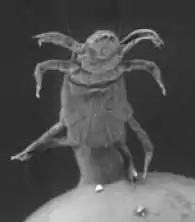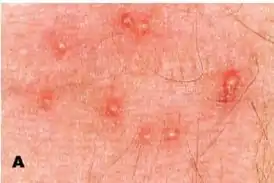Pyemotes
Pyemotes (лат.) — род микроскопических клещей семейства Pyemotidae из отряда Trombidiformes[3]. Имеют медицинское значение, вызывая дерматиты у человека, и как агенты биологического контроля насекомых-вредителей.
| Pyemotes | ||||||||||
|---|---|---|---|---|---|---|---|---|---|---|
 | ||||||||||
| Научная классификация | ||||||||||
|
Домен: Царство: Подцарство: Без ранга: Без ранга: Без ранга: Без ранга: Тип: Подтип: Класс: Подкласс: Надотряд: Отряд: Подотряд: Инфраотряд: Eleutherengona Гипотряд: Heterostigmata Надсемейство: Pyemotoidea Семейство: Pyemotidae Род: Pyemotes |
||||||||||
| Международное научное название | ||||||||||
|
Pyemotes Amerling, 1862[1][2] |
||||||||||
| Синонимы | ||||||||||
|
||||||||||
| Номенклатурный тип | ||||||||||
|
Pyemotes scolyti Oudemans, 1936 |
||||||||||
| ||||||||||
Описание
Микроскопического размера клещи, длина тела самок от 200 до 325 мкм, ширина от 70 до 125 мкм. Опистосома физогастрических самок образует шаровидную форму диаметром до 2 мм. Длина тела самцов от 190 до 200 мкм, ширина от 100 до 120 мкм. Гистеросома вытянутая, цилиндрическая или веретенообразная. Тело слабо склеротизированное и без грубых пунктур. Гнатосома субокруглая или овальная[4][5]. Некоторые виды (Pyemotes herfsi и другие) кусают людей и вызывают зерновую чесотку. Космополитический вид Pyemotes tritici встречается на соломе, сене и хранящемся зерне, паразитирует на мелких членистоногих. Он также связан с дерматитом у людей[6]. Когда клещи вступают в контакт с кожей человека, они пытаются там питаться, вызывая сильный зуд, часто по всей поверхности тела. Примерно через шестнадцать часов на поверхности кожи появляются пузырьки, похожие на волдыри, и другие симптомы могут включать головную боль, боль в суставах, лихорадку и тошноту[7].
 Укусы клеща на коже
Укусы клеща на коже_(18225620230).jpg.webp) Дерматит от Pyemotes ventricosus
Дерматит от Pyemotes ventricosus
 Физогастрическая самка
Физогастрическая самка_(16768724602).jpg.webp) Pyemotes ventricosus
Pyemotes ventricosus
Классификация
- Pyemotes acridivorous Chinniah & Mohanasundaram, 1999
- Pyemotes alastoris (Froggatt, 1894)
- Pyemotes anobii Krczal, 1957
- Pyemotes barbara Moser, Smiley & Otvos, 1987
- Pyemotes beckeri Krczal, 1957
- Pyemotes bruckeri (Oudemans, 1936)
- Pyemotes dimorphus Cross & Moser, 1975
- Pyemotes dryas (von Vitzthum, 1923)
- Pyemotes emarginatus Cross, Moser & Rack, 1981
- Pyemotes giganticus Cross, Moser & Rack, 1981
- Pyemotes herfsi (Oudemans, 1936)[8]
- Pyemotes mandelshtami Khaustov, 1999
- Pyemotes moseri Khaustov, 1998
- Pyemotes muraiae Mahunka & Mahunka-Papp, 1998
- Pyemotes pseudoscolyti Khaustov, 1998
- Pyemotes scolyti Oudemans, 1936
- Pyemotes schwertfegeri Krczal, 1959
- Pyemotes tritici (La Greze-Fossat & Montagne, 1851)
- Pyemotes tuberculatus Cross, Moser & Rack, 1981
- Pyemotes turkeyensis Yu, Zhang & He, 2010
- Pyemotes ventricosus (Newport, 1850)
- Pyemotes zhonghuajia Yu, Zhang & He, 2010
- Pyemotes zwoelferi Krczal, 1963
Примечания
- OConnor B., Klimov P. Family Pyemotidae Berlese, 1897. UMMZ Insect Division (30 April 2012). Дата обращения: 24 февраля 2022.
- Amerling, C. 1861. Naturökonomie der von ihm beobachteten Milben, insbesondere der Trombidieen. Sitzungsberichte Der Königlich Böhmischen Gesellschaft Der Wissenschaften In Prague.2: 54-56.
- Pyemotidae на сайте insects.tamu.edu. Архивировано 19 февраля 2014 года. Biology Catalog. Texas A&M University.
- Cross E. A. 1965. The generic relationships of the Family Pyemotidae (Acarina: Trombidiformes). Univ. Kans. Sci. Bull. 45: 29—275. BHL
- Cross E. A., Moser J. S. 1975. A new, dimorphic species of Pyemotes and a key to previously-described forms (Acarina: Tarsonemoidea). Annals of the Entomological Society of America. 68(4): 723—732.
- S. Rosen, I. Yeruham & Y. Braverman (2002). “Dermatitis in humans associated with the mites Pyemotes tritici, Dermanyssus gallinae, Ornithonyssus bacoti and Androlaelaps casalis in Israel”. Medical and Veterinary Entomology. 16 (4): 442—444. DOI:10.1046/j.1365-2915.2002.00386.x. PMID 12510897.
- Berenbaum, May. Ninety-nine More Maggots, Mites, and Munchers. — University of Illinois Press, 1993. — P. 31–32. — ISBN 978-0-252-06322-0.
- Alberto B. Broce et al. Pyemotes herfsi (Acari: Pyemotidae), a Mite New to North America as the Cause of Bite Outbreaks. 2006. J. Med. Entomol. 43(3): 610—613 (2006) pdf
Литература
- Cross E. A. 1965. The generic relationships of the Family Pyemotidae (Acarina: Trombidiformes). Univ. Kans. Sci. Bull. 45: 29—275. BHL
- Cross E. A., Moser J. S. 1975. A new, dimorphic species of Pyemotes and a key to previously-described forms (Acarina: Tarsonemoidea). Annals of the Entomological Society of America. 68(4): 723—732. pdf
- Menezes C., A. Coletto-Silva G. S. Gazeta, W. E. Kerr. 2009. Infestation by Pyemotes tritici (Acari, Pyemotidae) caused death of stingless bee colonies (Hymenoptera: Meliponina). Genetics and Molecular Research.8: 630—634.
- Yu L., Zhang Z.-Q., He L. 2010. Two new species of Pyemotes closely related to P. tritici (Acari: Pyemotidae). Zootaxa 2723: 1—40. https://dx.doi.org/10.11646%2Fzootaxa.2723.1.1